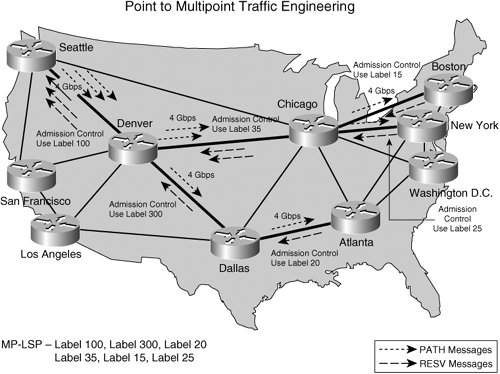MPLS Traffic Engineering and Multicast
| Another emerging application of MPLS traffic engineering is bandwidth-guaranteed multicast for video distribution. Currently, multicast traffic does not use LSPs in the network and traverses natively as IP. Recent developments in MPLS traffic engineering enable the building of point-multipoint TE tunnels using MPLS TE control plane and map multicast traffic to these TE tunnels for efficient packet replication in the core. Here is a simple explanation of how it works. As you learned earlier, MPLS uses RSVP messages to build traffic engineering tunnels. In the point-to-multipoint case, you have multiple tail ends and a single head end for the traffic-engineered tunnel. To build a point-to-multipoint tunnel, the head end must send PATH messages to all the tail end nodes with the same tunnel ID. The PATH messages are received by the tail ends, and the tail end nodes respond with a RESV message. While the RESV message travels back toward the head end node, along the path, each core node performs admission control and merges the LSP upstream with the matching tunnel indicated by the tunnel ID. The merged reservation continues upstream toward the head end node, thus creating a multipoint tree from the head end to the tail ends. (See Figure 8-7.) Figure 8-7. Point-to-Multipoint Traffic Engineering In this example, we need to send multicast traffic from Seattle to Atlanta, New York, and Boston. Three PATH messages are sent from Seattle to each tail end node in Atlanta, New York, and Boston with the tunnel ID "tunnel1." The tail end nodes reply with a RESV message and label mapping back toward the tunnel head end when the admission control process is complete. The RESV message from Atlanta travels back toward the Denver node and eventually back to the Seattle node. The RESV messages from New York and Boston travel back toward the Denver node via Chicago and then eventually back to Seattle. The Chicago node notices that multiple PATH and RESV messages with the same tunnel ID ("tunnel1") exist. When sending upstream RESV messages toward Denver, the Chicago node merges the two requests coming from New York and Boston with the tunnel ID "tunnel1" when responding with a RESV message to Denver. The Denver node in turn performs a similar merge function for RESV messages coming from Chicago and Dallas, thus creating branching points for traffic at Denver and subsequently at Chicago. Packets sent from the Seattle node are replicated at each branching point on the tree. The admission control process and the CSPF enable the building of a multipoint tree only on the links that have available bandwidth. Much like the point-to-point TE tunnels for unicast traffic, explicit and dynamic path options can be used for either the explicit placement of P-MP TE tunnels or the dynamic computation using CSPF. Using point-to-multipoint traffic engineering (P-MP TE), you can efficiently transport multicast traffic across an MPLS network. Video distribution requires the efficient use of network resourcesand P-MP TE can certainly help. |
EAN: 2147483647
Pages: 162